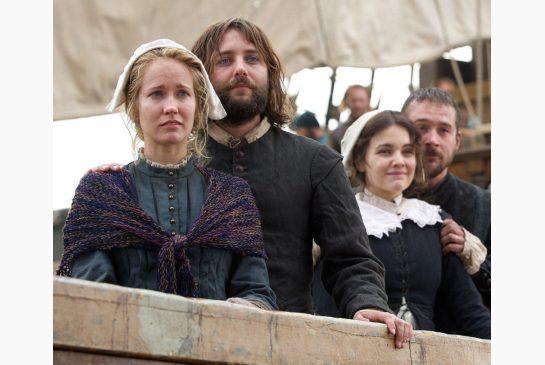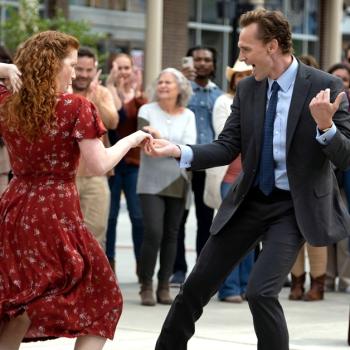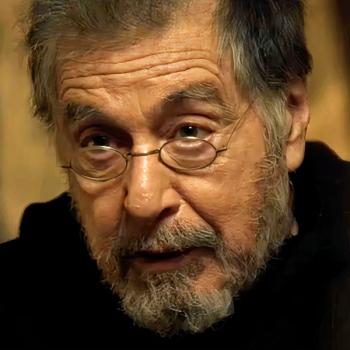It’s become fashionable in recent years to turn Thanksgiving (and Columbus Day) into an opportunity to bash Europeans for their imperialistic ways — as if the sins of Europeans were unique to them.
The flip side of this is to present Native Americans as helpless, wide-eyed, innocent victims of these rapacious invaders, who barely think of the “savages” as human beings.
Like most narratives created to suit political aims, it lacks nuance and a respect for truth — and it insults the very people it’s meant to celebrate.
Starting on Sunday, Nov. 22, at 9 p.m. ET/PT, National Geographic Channel presents the two-night miniseries “Saints & Strangers,” the story of the English settlers who arrived in North America (ironically, the miniseries filmed in South Africa) aboard the Mayflower, and the people already there who greeted them.
Impressively filmed and acted, the script by executive producers Seth Fisher and Eric Overmyer resists the impulse to demonize or lionize either the English or the Native Americans, or to treat the two groups as homogeneous entities. Some of the colonists were pious Puritans (a k a Pilgrims); others were just seeking freedom from debt or a new place to live. The local tribes warred as much among each other as they did with the outsiders.
The Native Americans lacked the technology and the sheer numbers to resist the influx into their land — a fate shared by every group of people on Earth at one point or another. In addition, long isolation on a continent bounded by huge oceans left them vulnerable to communicable diseases that wouldn’t necessarily decimate another population.
Also, as the miniseries shows, each tribal nation had its own customs, history and priorities, which made uniting against invaders difficult.
At the same time, the English settlers crack along religious and economic lines, according to their priorities. And they’d only been told that the natives were monsters, so landing in this utterly alien land, they were surprised to be facing, not horned demons, but flesh-and-blood people.
Perhaps the most impressive accomplishment of “Saints & Strangers” is to give each group its full humanity. The English were not necessarily evil. They saw a way out of their oppression, and they took it. The Native Americans were not children or Rousseau’s “noble savage.”
Instead, they were intelligent, sophisticated, flawed and fully realized human beings who found themselves in a no-win situation. Some reacted to it with openness and
charity; others with fear and defensiveness. In that, they are much like the English settlers, who were an equal mixture of virtue and vice.
History is a long chain of conquerors and conquered. Unfortunately for the Native Americans, by the time Europeans arrived in the Americas, they had long experience of both, and the weaponry and tactics to deal with it. Many island populations — and America is a big island, after all — with limited threats from the outside never develop strong defenses to cope with invasion. They never have to.
But from the Stone Age settlers through the Celts, the Romans and the Anglo-Saxons, the people of England knew what it was like to be subjugated, and they’d figured out very well how to subjugate others (just ask the Irish).
As relatively small nations who hadn’t needed to, or been able to, develop fortifications or heavy weaponry — and these things having never been introduced to them by an outside invader — the Native Americans had few ways to combat this.
“Saints & Strangers” does show that the Pilgrims were serious about their Christian faith, and in the epilogue, it’s revealed that one of the main Native American characters converted to Christianity. Many today would consider that an imposition of culture, but it can also be viewed as the choice of an individual who had the intellect and will to know his own mind.
Also, the actors portraying the Native Americans — including Raoul Trujillo, Tatanka Means and Kalani Queypo — learned the Eastern Algonquian language of the Western Abenaki, which adds another layer of verisimilitude.
The creation of what is now the United States of America is a bloody, complex, violent, hopeful, noble and tragic story, and just who is a saint and who is a stranger is not always easy to determine at first glance.
The greatest triumph of “Saints & Strangers” is to show that, whichever we are at any moment in time, we are all human.
Other cast members include Vincent Kartheiser (as Puritan leader William Bradford, pictured above, with Anna Camp), Ray Stevenson, Ron Livingston, Natascha McElhone, Brian F. O’Byrne, Barry Sloane and Michael Gibson.
Here’s a sneak peek:
Images: Courtesy National Geographic Channel
Don’t miss a thing: head over to my other home at CatholicVote and like my Facebook page.















